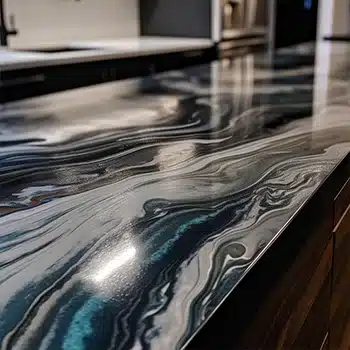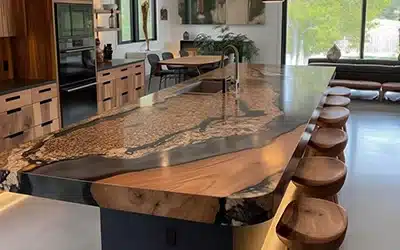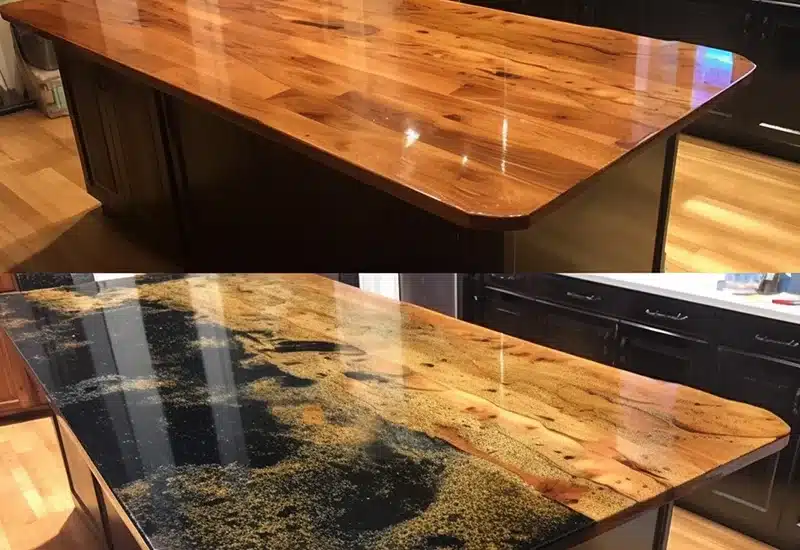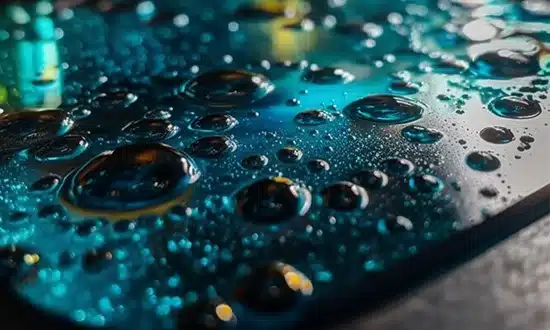CALL OR TEXT : 954-919-9628
Satin Finish Epoxy Countertop
Introduction to Epoxy Countertops
Epoxy countertops are becoming increasingly popular among homeowners and interior designers, thanks to their unique properties and customizable appearance. By applying a layer of epoxy resin over a countertop substrate such as wood or concrete, you can create a durable and attractive surface. One of the most popular finish options for epoxy countertops is the satin finish, which offers a smooth, matte look that’s both stylish and functional. At Value Painting and Flooring, we provide a range of services, including epoxy countertops to help you create your dream kitchen.

Benefits of Satin Finish Epoxy Countertops

The satin finish offers several advantages over other types of epoxy countertop finishes, such as high gloss or textured surfaces. Here are some of the key benefits:
Durability and Strength
Satin finish epoxy countertops are known for their strength and durability. The epoxy resin forms a strong bond with the countertop substrate, resulting in a surface that’s resistant to scratches, stains, and impacts. This makes it an ideal choice for busy kitchens and workspaces. Check out our gallery for examples of our work.
Easy Maintenance
Cleaning and maintaining a satin finish epoxy countertop is a breeze. The nonporous surface is resistant to bacteria and germs, making it a hygienic choice for your home. Plus, the matte finish is less likely to show fingerprints and smudges compared to high-gloss alternatives. Visit our blogs for more tips on maintaining epoxy surfaces.
Aesthetic Appeal
The smooth, matte appearance of a satin finish epoxy countertop adds a sophisticated touch to any space. The finish can also help to diffuse light, reducing glare and creating a more comfortable environment. Learn more about other finishes like faux Venetian plaster for additional design inspiration.
Customization
Epoxy countertops offer nearly limitless customization options. You can choose from various colors, patterns, and even incorporate unique elements like metallic flakes or embedded objects. With a satin finish, you can achieve a one-of-a-kind look that complements your personal style and home décor. Discover our full range of services to explore more customization options.
How to Apply a Satin Finish Epoxy
Applying a satin finish epoxy to your countertop involves a few key steps. Here’s an overview of the process:
Materials Needed
- Epoxy resin and hardener
- Satin finish additive
- Mixing containers and stir sticks
- Measuring cups
- Trowel or squeegee
- Painter’s tape
- Plastic drop cloth
- Gloves, mask, and safety goggles
Surface Preparation
Before applying the epoxy, thoroughly clean your countertop and remove any dust or debris. If necessary, sand down any rough spots or uneven surfaces. Apply painter’s tape around the edges of the countertop to protect adjacent surfaces.
Mixing and Applying the Epoxy
Following the manufacturer’s instructions, mix the epoxy resin and hardener in the appropriate ratio. Then, add the satin finish additive and mix thoroughly. Once the components are combined, you’ll have a limited working time, so it’s important to work quickly and efficiently.
Pour the mixed epoxy onto the center of the countertop and use a trowel or squeegee to spread it evenly across the surface. Ensure that the epoxy covers the entire surface and reaches all edges. You may need to use a brush for tight corners or edges.

Curing and Polishing
Allow the epoxy to cure according to the manufacturer’s recommended time, typically 24 to 72 hours. Keep the area well-ventilated and avoid exposing the countertop to dust, moisture, or extreme temperatures during the curing process.
Once the epoxy has fully cured, you can polish the surface with a fine-grit sandpaper or polishing pad to achieve the desired satin finish. Be sure to clean the countertop thoroughly after polishing to remove any dust or debris.
Troubleshooting Epoxy Application Issues
While applying a satin finish epoxy countertop can be a rewarding DIY project, it’s not without its challenges. Here are some common issues and solutions:

Bubbles
Bubbles may form in the epoxy during mixing or application. To minimize bubbles, mix the epoxy slowly and avoid introducing air into the mixture. If bubbles appear during application, you can use a heat gun or propane torch to gently warm the surface and help release the trapped air.
Uneven Surface
An uneven surface can occur if the epoxy isn’t spread evenly or if the countertop isn’t level. Before applying the epoxy, ensure that your work surface is level and free of any imperfections. During application, use a trowel or squeegee to spread the epoxy evenly, paying close attention to edges and corners.
Incomplete Curing
If the epoxy doesn’t cure completely, it may remain tacky or soft. This can be caused by incorrect mixing ratios, insufficient curing time, or exposure to extreme temperatures or humidity. Always follow the manufacturer’s instructions for mixing and curing, and ensure that the work area is well-ventilated and free from temperature fluctuations.
Concluding Thoughts on Satin Finish Epoxy Countertops
A satin finish epoxy countertop is a durable, low-maintenance, and attractive option for any home or workspace. With proper application and care, you can enjoy the benefits of this unique surface for years to come. Don’t be afraid to experiment with colors and additives to create a customized look that reflects your personal style. At Value Painting and Flooring, we’re here to help you with all your epoxy needs. Contact us today for a free estimate and let’s get started on your dream kitchen!
Frequently Asked Questions
How long does a satin finish epoxy countertop last?
With proper care and maintenance, a satin finish epoxy countertop can last for many years. The durability of the surface depends on factors such as the quality of the epoxy, proper application, and usage.
Can I apply a satin finish epoxy over an existing countertop?
Yes, you can apply a satin finish epoxy over an existing countertop, provided that the surface is clean, free of damage, and properly prepared. It’s essential to follow the manufacturer’s instructions for surface preparation and application to ensure a successful outcome.
Is a satin finish epoxy countertop heat resistant?
While epoxy countertops have some degree of heat resistance, they can be damaged by direct exposure to high temperatures, such as hot pots and pans. Always use a trivet or heat pad to protect the surface from extreme heat.
Can I cut directly on my satin finish epoxy countertop?
Although epoxy countertops are scratch-resistant, it’s not recommended to cut directly on the surface, as it can cause damage over time. Always use a cutting board to protect your countertop.
How do I clean and maintain my satin finish epoxy countertop?
To clean and maintain your satin finish epoxy countertop, simply use a soft cloth or sponge with mild soap and warm water to wipe the surface clean. Avoid using abrasive cleaners or scouring pads, as they can scratch the finish. For stubborn stains or residue, you can use a non-abrasive cleaner or a small amount of rubbing alcohol. Regularly wiping down your countertop and promptly cleaning up spills will help maintain its appearance and longevity.
